Are you tired of the 9 to 5 grind and looking for a way to make passive income from the comfort of your own home?
Starting an affiliate marketing website or blog might be the answer you’ve been looking for.
However, let’s get one thing straight: there are no shortcuts to success in this game.
Despite what some online gurus may promise, making a sustainable income through affiliate marketing requires hard work, dedication, and a lot of patience.
If you’re willing to put in the time and effort, building an affiliate blog can be a rewarding and lucrative venture.
In this post, I’ll guide you through the steps to get started and give you some tips for success
In this guide, we’re talking about affiliate websites that do not require any initial investment (except for the web hosting plan).
But be warned: this is not a get-rich-quick scheme. It can take 6-12 months of full-time work to start seeing significant results. So, if you’re ready to roll up your sleeves and put in the work, let’s dive in.
How Do Affiliate Sites Work?
Typically, an affiliate website is just traditional a blog with product recommendations.
An affiliate marketer writes content that ranks high on search engines. Some of that content has affiliate links to products that people can purchase.
To become a successful affiliate marketer, you need to step between a customer and a retailer.
You need to target people who are really close to making a purchase—people who are looking for information with credit cards in their hands.
With a blog, this means you need to write affiliate posts that rank high on Google.
At the end of the day, you should write blog posts that rank high for searches similar to “Best Running Shoes for Kids” for example.
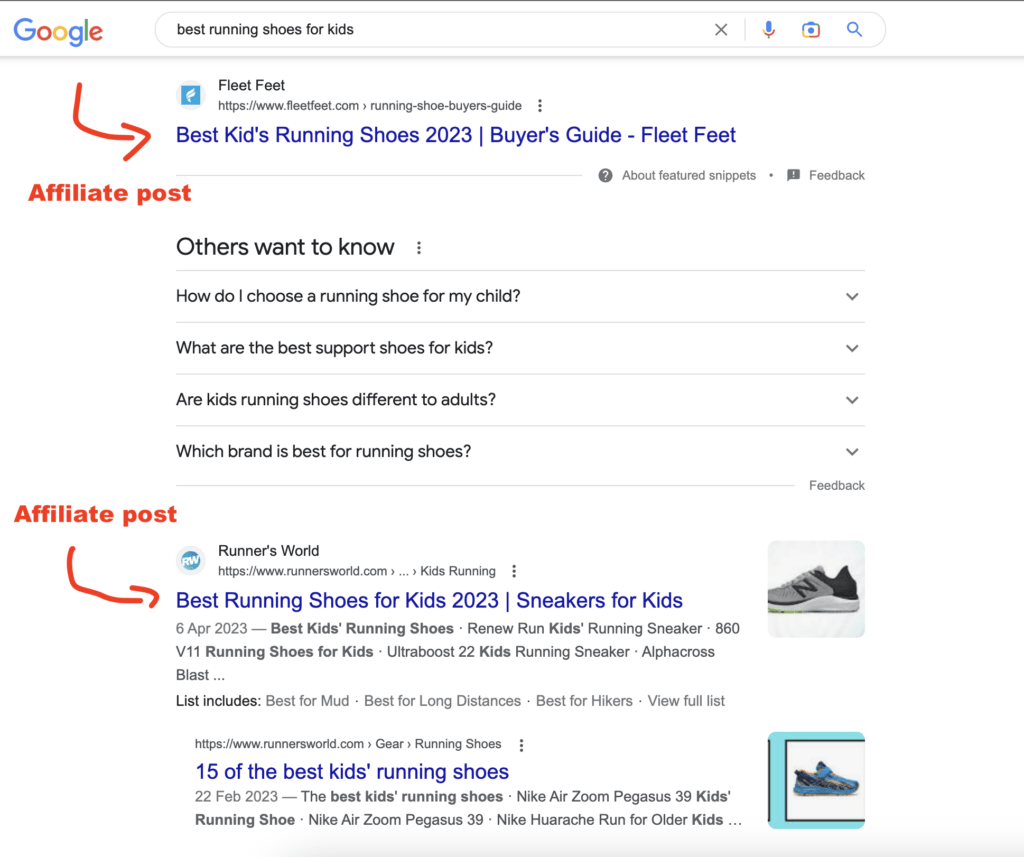
Someone searching for this is looking to find a pair of shoes and is ready to purchase right away.
If you manage to rank high with a post like that, you will get traffic and a small portion of them will buy shoes and earn you a commission.
However, it takes a ton of time and effort before you can rank for those kinds of search phrases.
You will learn how to build trust in the eyes of search engines later on in this guide. For now, it’s just enough to understand what affiliate marketing is and how affiliate websites work.
There are many types of affiliate marketing.
People use social media to attract potential customers to products they’re partnering with. Also, some affiliate marketers run ads to attract customers to their partner’s landing pages.
All those “Use promo code Alice95 to get 20% off” are forms of affiliate marketing.
The most common, and in my opinion, the easiest, safest, and most stress-free way to do affiliate marketing is by running a blog. This requires no initial investment, marketing skills, or audience.
Starting an Affiliate Website in a Nutshell: 5 Steps
Here’s a short overview of what it takes to build an affiliate marketing business with a blog.
- Finding a niche – Choose a specific topic or area of interest that you care about and more importantly, has the potential for profitability.
- Building a blogging site (WordPress.org) – Create a website using WordPress.org, which offers more flexibility and control over your site.
- Writing informational posts about the niche to become an authority – Create high-quality, informative content that provides value to your readers and establishes your authority in your niche.
- Establish authority in a niche – Building authority takes time and consistency. Be patient and continue creating valuable content. Write at least 50-100 quality informational posts.
- Learn how to write affiliate posts and start writing them – Once you’ve established yourself as an authority, start incorporating affiliate links into your content to generate income.
Remember, starting an affiliate blog takes a lot of work and dedication. It may take up to six months or more to earn a commission from an affiliate site.

In a sense, starting an affiliate blog is no different than starting any other blog.
You first need to build a site and provide value with it to the web searchers.
When Google and other search engines trust your site, you can start publishing affiliate content on it.
Now that you roughly understand what it takes to start an affiliate blog, let’s take a closer look at the steps you need to take to actually start an affiliate blog.
1. Find a Niche
Before starting an affiliate blog, it’s important to find a niche for your blog.
Back in the day, the niche didn’t really matter.
You could just have one general blog that covers all sorts of niches in a random and inconsistent fashion.
Anyone could write a blog post that ranked high on Google. But that kind of Internet is not a good place.
These days, Google and other search engines prefer expertise, authority, and trustworthiness (E-A-T). A blog that’s not an established player in a niche won’t rank high on search engine results pages—which is good.

But for bloggers, this means there’s more work to be done.
To have a higher E-A-T with your blog, you need to choose a niche and stay consistent within it. In other words, you need to write a ton of quality blog posts about that topic for months or even years to come.
When choosing a niche, you can’t arbitrarily pick one. Instead, you need to do careful competitive research.
Your goal is to figure out if:
- There’s room for a one-person blog to rank high.
- There are affiliate programs.
- You actually want to write about the niche for years to come.
Make sure to read my complete guide to choosing a good and profitable blogging niche.
2. Build a Blog
Once you’ve chosen a niche, it’s time to build a blog (i.e. a website).
These days, you don’t need any technical skills to build a website. As a matter of fact, it’s as easy to start a Facebook page as it is to get a blog up and running.
I recommend using WordPress.org (not WordPress.com).
WordPress.org is the most popular solution for building websites and blogs. It’s scalable and robust.
Using WP requires no technical skills and you can get a site up and running in 15-30 minutes.
Notice that you could test the waters by signing up for a blogging platform like Medium.com.
But if you’re serious about affiliate marketing, you should start your own affiliate blog—not do it on another business’s website.
You can find detailed steps for launching your affiliate blog in this guide.
3. Write Informational Posts
Once you have a website up and running, it’s time to start writing blog posts for it.
Before you write any affiliate posts, you need to write a ton of informational content that’s relevant to your niche.

This is because your website needs to build trust in the eyes of search engines.
If you start writing affiliate posts right off the bat, your site won’t do good.
You’ll just end up looking greedy. Search engines and your audience can easily detect this!
How to Choose Blog Post Topics
The secret is that you don’t come up with blog post topics yourself. Instead, you use Google’s data to see what people are searching for.
To write a successful blog post, you need to do careful research. This is because you want to target people in your niche and also make sure your post topic is not too competitive.
Luckily, you can do blog post topic research on Google for free.
To find blog post topic ideas, you can use Google Search suggestions. This gives you an idea of what people are searching for.
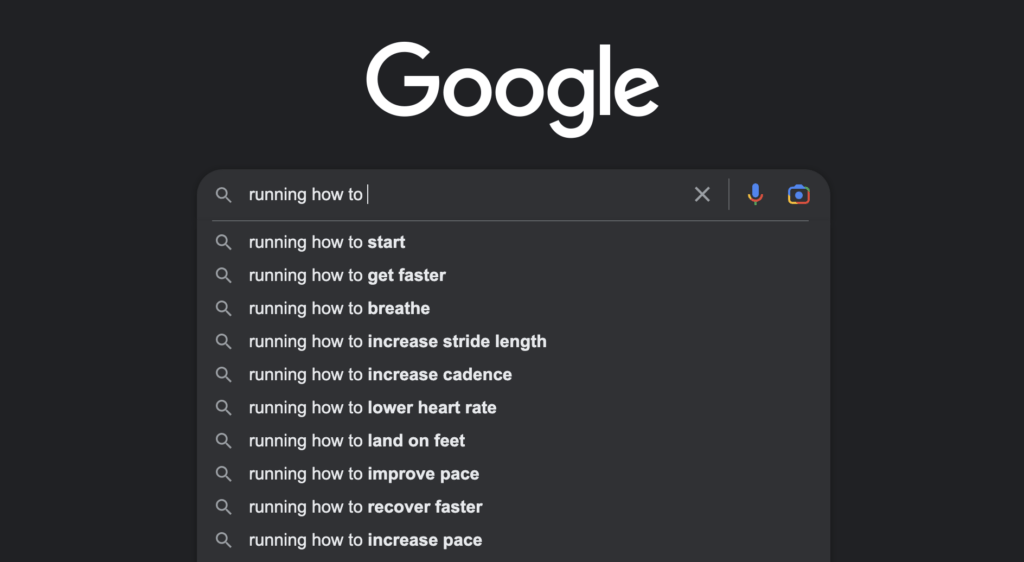
These suggestions are your blog post candidates. However, you can’t still just write them out. This is because the competition might be through the roofs.
With a brand-new site, you won’t be able to rank high for competitive search phrases.
Stay away from “short-tail” topics like “How to Lose Weight”—those are way out of your reach.
Instead, go for something way more specific, such as “Best Weight Bearing Exercises at Home for Seniors”.
One way to get a good idea of the competition is by analyzing the search results.
Are there notable “authority sites” like Forbes in the search results? If there are, your chances of outranking those sites are marginally small.
Also, if there are tons of ads and other search features the competition is likely through the roofs.
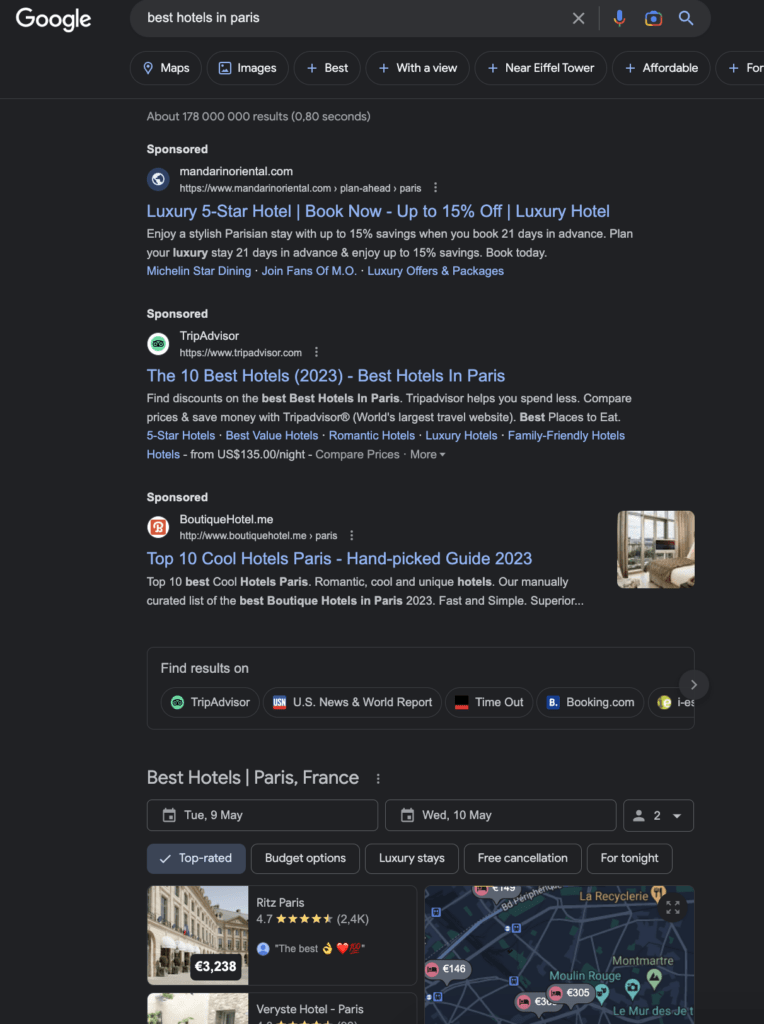
On the other hand, if no search result clearly answers the search question, that might be a good sign.
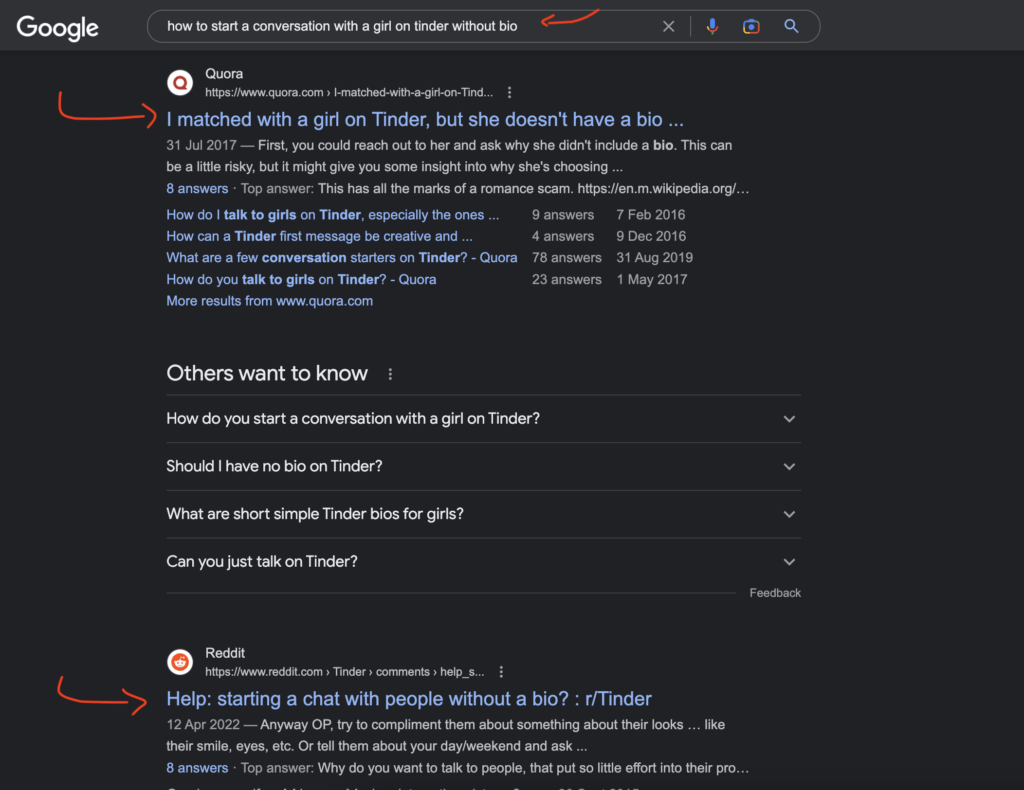
But if there are forum posts or small blogs in the top search results, that is a good indicator that there might be room for your site as well.
Don’t forget to match the search intent too!
Every Google search has an intent. Google and other SEs determine the intent and suggest results based on it.
For example, by Googling “How to Tie Shoelaces”, you get images and videos.
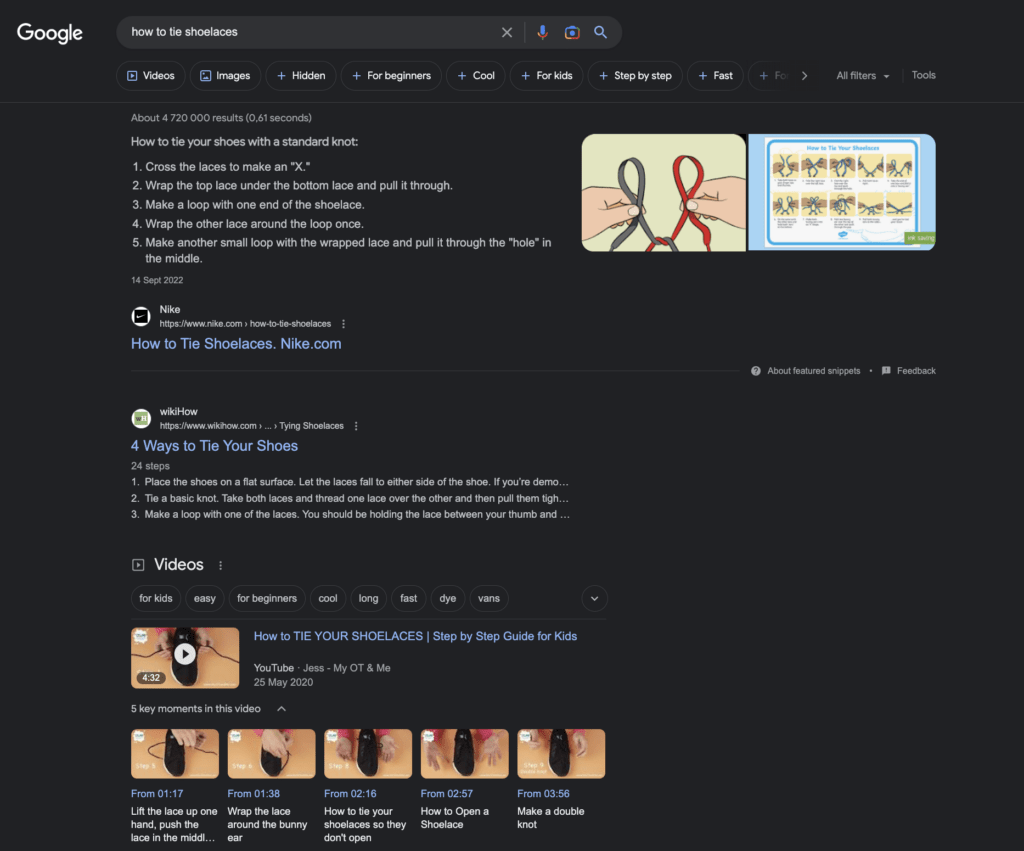
This suggests that a blog post is not a great fit for the search query. The intent is clearly to see a helpful video or visual guide instead of reading a post.
Write Long-Form Content
Now, if you want to have any chance of ranking high, you need to write long-form content.
Your blog posts need to be better than any existing pieces. Otherwise, search engines won’t rank your posts.
Usually, this means writing blog posts that are much longer than 2,000 words in length.
My best-performing articles are up to 14,000 words in length.
Obviously, this depends on the case.
If you’re lucky enough to be the first to cover a topic (never happened to me, BTW), 100 words might be enough.
But if you’re competing against hundreds of their posts, you need to write the most detailed (and the longest) post on the internet.
Last but not least, you need to provide value with your content. Leave no stone unturned. Answer the search question as thoroughly as possible.
Don’t just write a short and concise post that quickly answers a question. Do it in a way that’s better than anyone else has done on the internet about that topic.
Here’s a great example of a bad blog post outline vs. a good blog post outline:
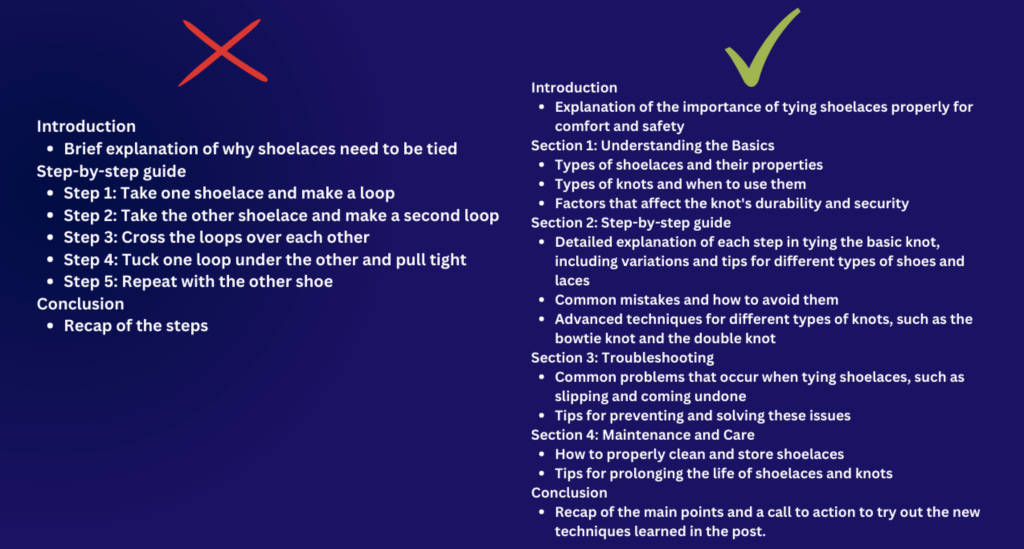
Provide the visitor with insightful resources, facts, images, and such.
Format the posts nicely by using headings, subheadings, bulleted lists, and tables to make them more skimmable.
4. Wait Until 10,000 Monthly Visitors
Before writing affiliate posts, it’s important you establish yourself as an authority in your niche. If Google doesn’t trust your site, it won’t show affiliate posts high on search results.
The best way to know when your site has some authority is when it ranks high and brings in traffic.
Once you have let’s say 10,000 visitors to your site, you can start considering writing affiliate posts.
This is not a hard and fast rule either.
In some niches, 10,000 visitors might be something you will never reach. But in most niches, that’s attainable.
Common sense here won’t hurt here—we’re not doing exact science here, anyway! 🙂
Nonetheless, you can’t just “wait” for this to happen. Instead, you need to write a ton of content all the time!
5. Start Writing Affiliate Posts
Once you have 50-100 niche-specific informational blog posts and a ton of monthly visitors to your blog, you can start pushing out some affiliate content.
Remember, you will still need to write a ton of informational posts for your blog too!
This is because search engines can easily see if you’re greedy and only blogging to make money with affiliate content.
I’d say a perfect balance between the affiliate and non-affiliate content is about 1:4.
For 1 affiliate post, you should write about 4 informational posts.
Your site’s main goal should remain to solve problems and provide value for readers—not to make money.
Next, I’ll show you the three types of affiliate posts you are going to write. These are the main affiliate post types you ever need to consider.
Affiliate Blog Post Types
Notice that 99.9% of blog post ideas are bad when it comes to affiliate marketing.
Consider a blog post “How to tie shoelaces.” This might be a good informational post, for sure. But it has no transactional value.
Someone who’s searching for this already has shoes and there’s no buying intent. If you place affiliate links of shoes to a post like this, no one will buy from you.
Affiliate marketing is not about placing random affiliate links all over your website. If you’re not very strategic and careful with affiliate links, you won’t make money.
To help start affiliate marketing on a blog, there are three main types of affiliate posts. When you write an affiliate post, it basically always needs to be one of these:
- Product roundup post. (E.g. “10 Best Keyboards for Gamers”)
- Product review posts. (E.g. “Photoshop Review”)
- Product alternative posts. (E.g. “15 Photoshop Alternatives”)
Any other blog post type has a way smaller revenue potential.
Of course, some how-to guides can include affiliate links to products required to complete the guide. However, most of the time, those don’t perform nearly as well!
Let’s take a closer look at each blog post type.
#1 Roundup Posts
A roundup post is an affiliate blog post that reviews the best tools in a particular category.
Here’s an example table of contents of one of my roundup posts on this blog.
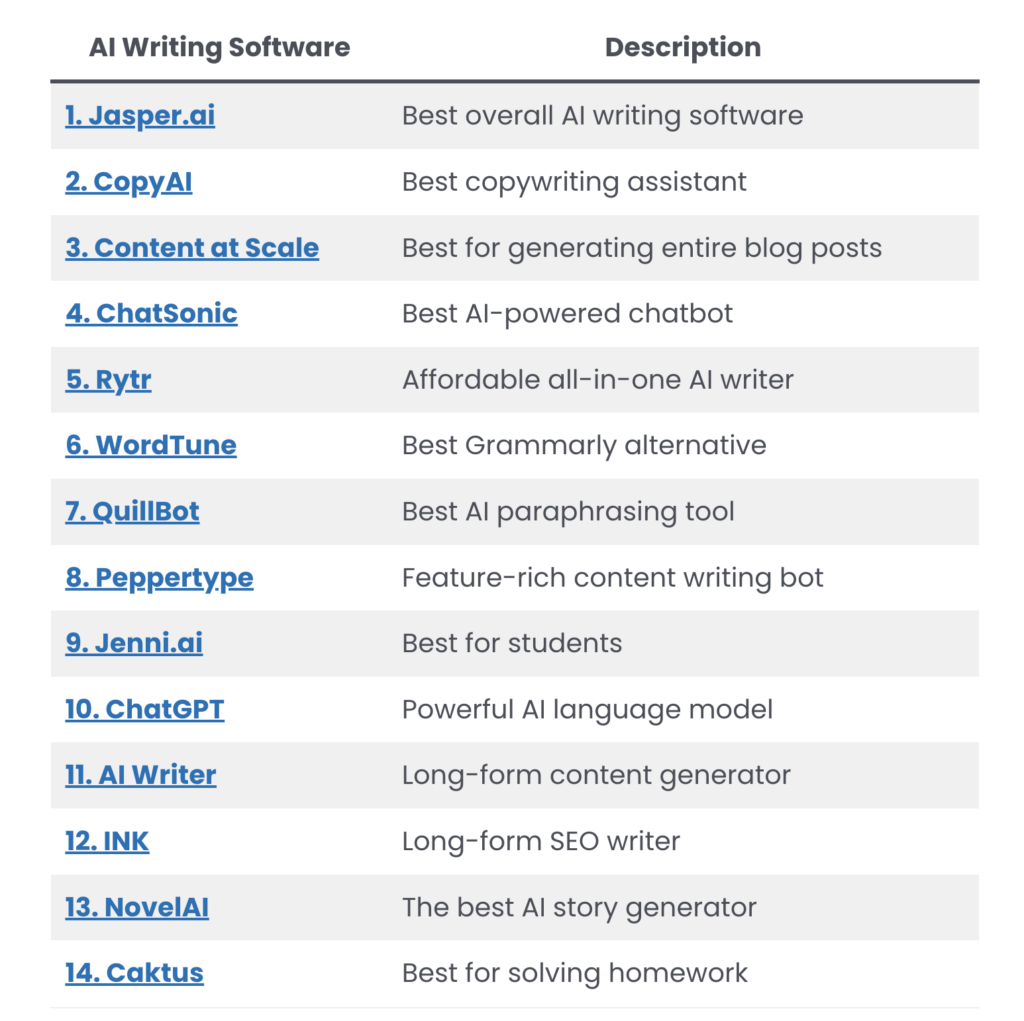
The idea of a roundup is that you introduce the products for a person that’s looking to make a purchase.
In a roundup post, each product has a call-to-action link to test the product in question.
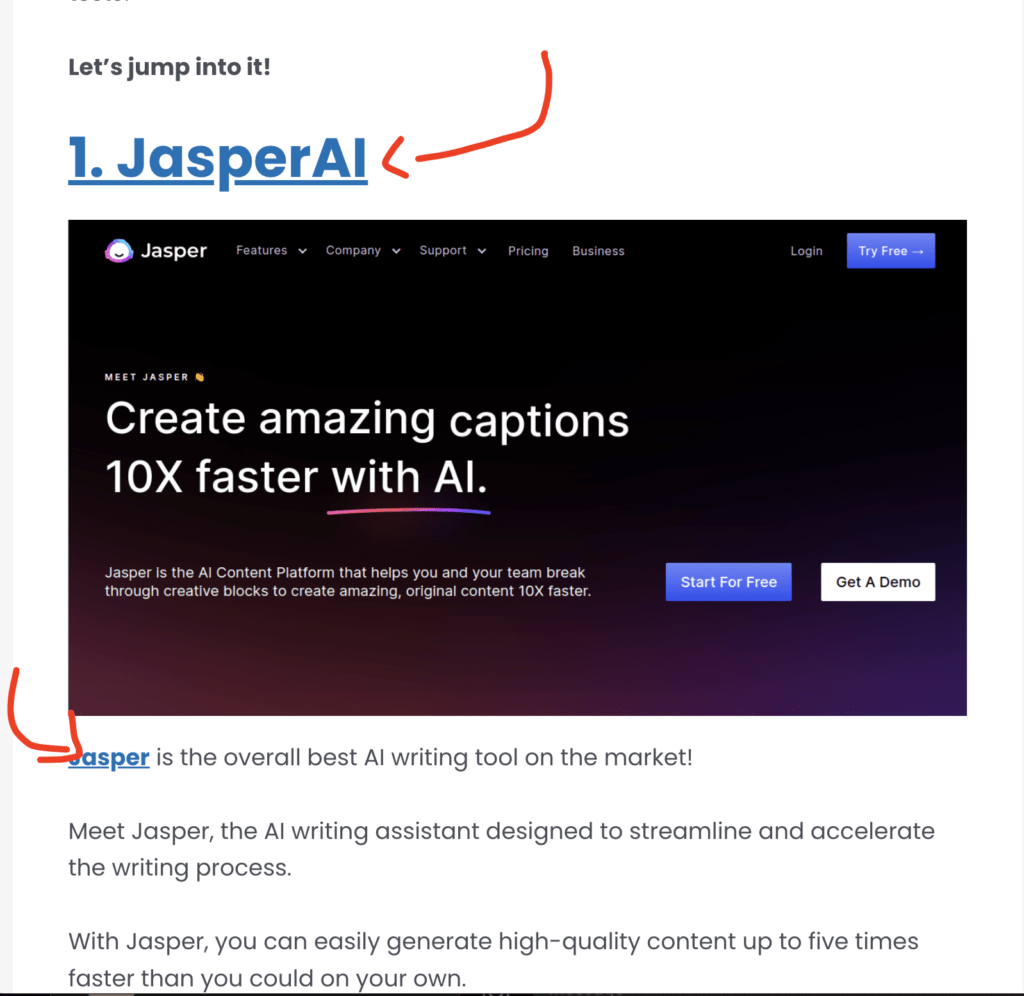
The CTA link is an affiliate link. If someone makes a purchase through the link, the author makes a commission.
A roundup post is super easy to write—it just takes time, though.
All you need to do is search for the best products/tools in your niche and recommend/review those in your posts.
A typical roundup post could be titled like this:
- 7 Best Shoes for Running
- 15 Best Mouses for Gaming
- 15 Best Photo Editing Tools for Designers
How to Write a Roundup Post
To write a successful roundup post, you need to find a topic that’s not too competitive but still has search volume.
The best way to do this is by checking what kinds of products people are looking for in your niche. You can use Google suggestions, your competitor’s blog post topics, and common sense to get a better idea. 🙂
To write the actual post, you need to:
- Google products in your niche that have affiliate programs
- Add the products to your blog post
- Write a short (100-500 word) review for each product
- Rank the products based on your research or experience
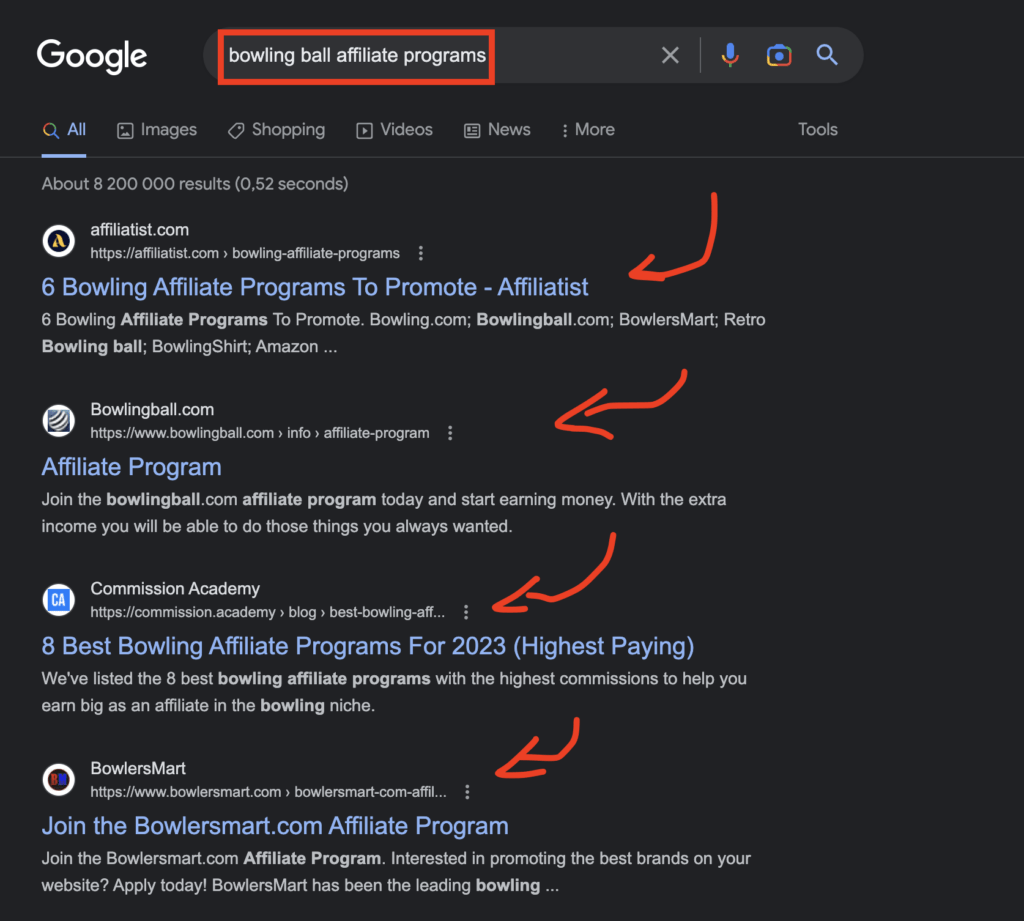
Remember, just like any other blog posts, these need to provide value too! Your affiliate roundup post won’t rank on Google unless it’s the best post about that topic! 🙂
Should You Test the Products, Though?
In an ideal world, you should try every single tool you put on the roundup post. This way, you can give an accurate and honest opinion about the tools/products you recommend.
However, many times testing the products in a roundup post is simply not possible due to time constraints or pricing.
For example, to write about the best design tools, you’d need to use them for months or even years—preferably in a professional setting, such as work or as a freelancer.
Needless to say, this is infeasible—no one has time for that.
An efficient blogger should be able to publish at least one blog post a day, so writing a single post for weeks or months makes absolutely no sense.
Also, there’s no guarantee that a carefully written affiliate post will ever rank. So there’s a great chance your effort is in vain.
Based on my experience, a typical affiliate site spends 2-20 hours writing a roundup post. During this time, they do the testing and writing.
#2 Reviews
Another common affiliate post type is a good old product review.
The idea is simple. Try a product and write a comprehensive review of it. This product needs to be something that’s related to your niche and that your audience would truly find insightful.
Don’t review products that aren’t related to your niche. This way you just confuse Google and other search engines.
To make money with a traditional product review, place affiliate links to that product in the post. Obviously, you need to make sure the product has an affiliate program before writing a review.
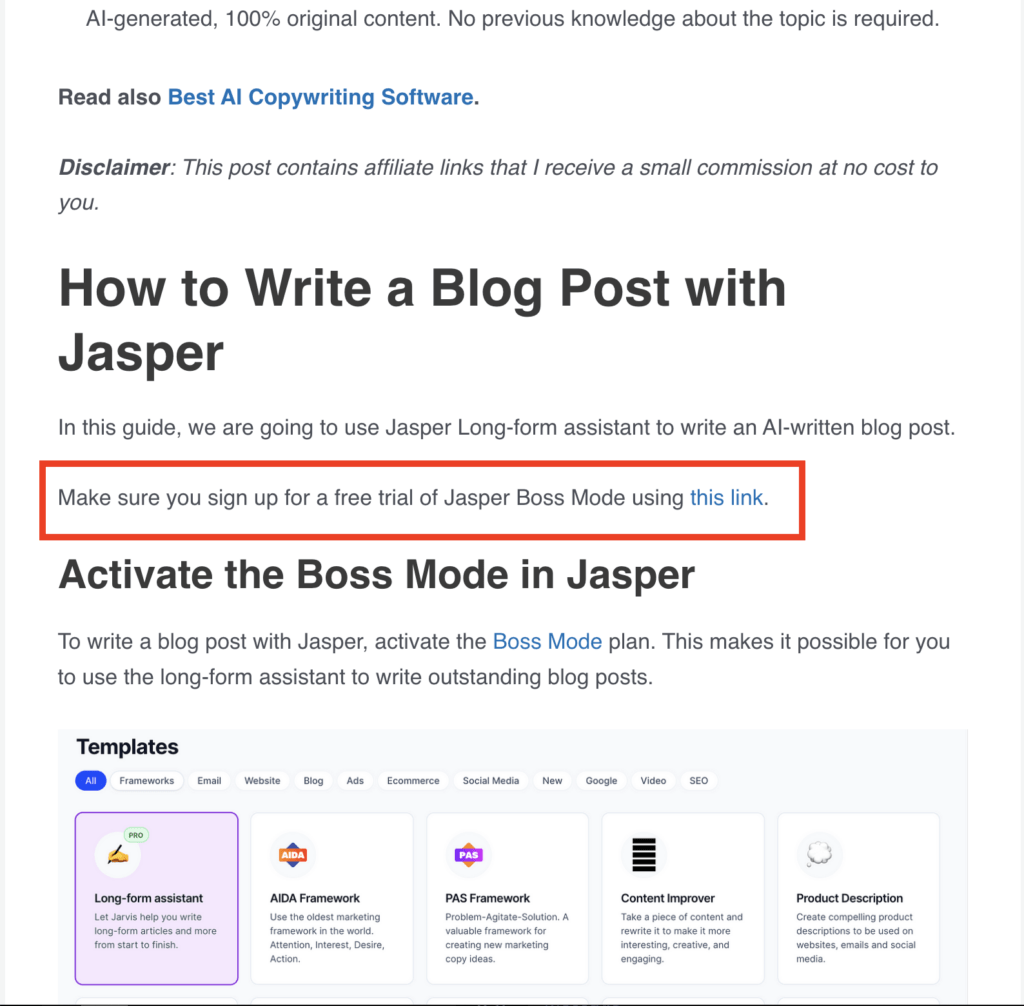
If your review convinces someone to make a purchase, you earn a commission. If you’ve extensively tested a product, you’ll be able to write a nice and honest review of it.
Most of the time, a review is more than 2,000 words in length. You need to touch every aspect of the product and consider a plethora of different use cases.
To rank high, you need to write the most detailed review of the product on the internet.
Remember to be honest in the review. No product is perfect. Always list some pros and cons!
#3 Alternative Posts
The third affiliate post type is the “alternatives post”.
The power of alternative products is based on the fact that people are looking for alternative products.
For example, here’s an alternative post for an AI productivity tool called Jenni AI:

This post does well because Jenni AI is such a popular tool that tons of people are looking for alternatives to it.
But why?
Sometimes the price is not right or the features are limited.
Also, people are curious and want to make sure that a product is best for their use case.
If there’s a popular product, chances are people are searching for alternatives to it.
For example: “Photoshop Alternatives” or “Nike Alternatives”.
Those “product alternative” searches make for good affiliate post topics.
Essentially, an alternative post is just a roundup post that lists the best products on the market.
To write a successful alternative post, search for alternatives to the product you want to write about. Then just write a roundup about those!
Important: Do the Research First
Before writing a single affiliate post, you need to do careful research. You want to make sure:
- There are affiliate programs for the products.
- There’s not too much competition.
- There are people searching for those products.
- The products are relevant to your audience.
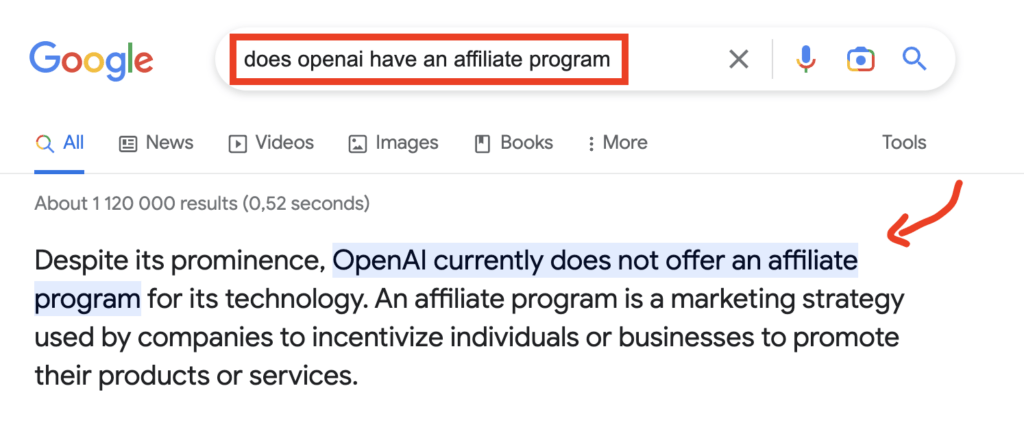
All these criteria need to be fulfilled before writing. Otherwise, your post won’t find any success.
But luckily, you’ve already become good at competitive analysis when writing those information posts I taught earlier. 🙂 Researching affiliate blog post topics is exactly the same.
At this point, you might want to check my free blogging masterclass. In the masterclass, I teach everything you need to know about blogging and affiliate marketing.
Balancing Affiliate Posts
Don’t build an affiliate blog that’s 100% affiliate content.
First, you need to write those 50-100 niche-specific informational posts that have no affiliate links whatsoever.
Then, you should continue writing informational content to provide value and drop an affiliate post here and there.
There’s no hard and fast rule as to how many affiliate posts per informational post you should write.
But a good balance is about one affiliate post per four informational posts.
If you step in the shoes of your audience, this makes sense. If all your posts are affiliate posts, you look greedy. But if your content tries to solve problems without monetary intentions, it builds trust.
Remember to Disclose Affiliate Links!
It’s illegal to place affiliate links to blog posts unless you clearly disclose them in the post. The reader needs to know that the post is done in partnership with another company.
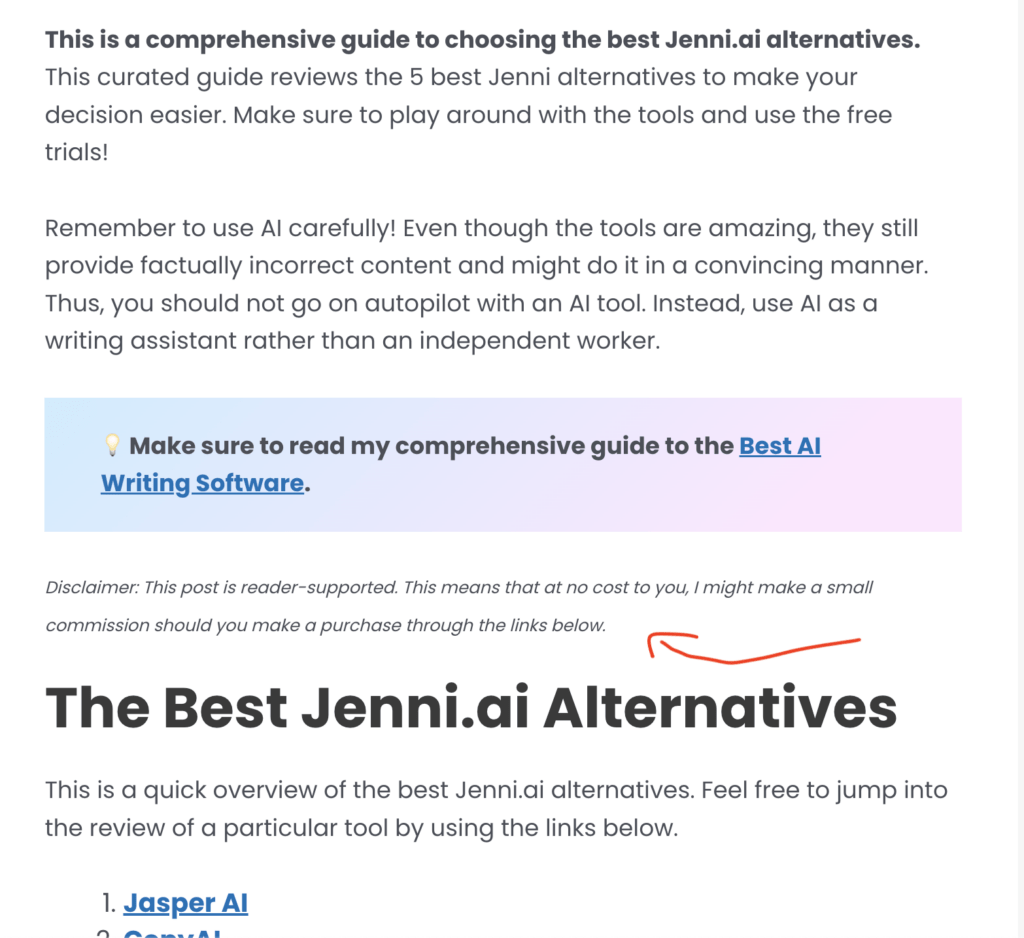
Here’s why you need to disclose the affiliate links.
- Transparency: Disclosing affiliate links is a matter of transparency and honesty with your readers. It lets them know that you may receive compensation if they click on the link and make a purchase, which helps to build trust and credibility with your audience.
- Legal requirements: In many countries, including the United States, the Federal Trade Commission (FTC) requires bloggers and influencers to disclose any material connection they have to a product or service they endorse, including affiliate links. Failure to disclose this information can result in fines and legal action.
- Ethical considerations: Disclosing affiliate links is also an ethical consideration. It allows readers to make informed decisions about whether to trust and act on your recommendations, and it ensures that you are not misleading or deceiving them for financial gain.
Here’s an example of an affiliate disclosure:
Disclosure: This post is reader-supported and has affiliate links at no cost to you. I may earn a commission if you purchase through one of the links. I only recommend products I truly believe in.
Affiliate Blogging Mistakes
There are big mistakes every new affiliate tends to make. I’ve made all these mistakes too, unfortunately 🙂 But hey, at least I can tell what not to do!
Affiliate marketing is straightforward, but not always that intuitive. Also, it takes time to succeed.
If you see someone saying they make $10,000+/mo from affiliate marketing, they’ve probably spent years building their site.
So don’t expect success overnight. It takes a year or a couple of years of hard and strategic work to make it work (assuming you won’t spend money on freelancers, and so on.)
Nonetheless, here are what I think are the biggest mistakes to do with affiliate marketing as a blog monetization strategy.
#1 Monetizing too early
Don’t write affiliate posts or add affiliate links before your site has at least 50-100 posts and a ton of traffic (e.g. 10,000+/month).
When you have a site with traffic, Google trusts it more. This means they might place your affiliate posts high on search results too.
#2 Not understanding search intent
Don’t add affiliate links anywhere else but your affiliate posts that target high-converting traffic. For example, a post “How to tie shoelaces” has no buying intent.
The person who’s searching already has shoes. On the other hand, “Best shoes for running” has buying intent. An affiliate link to shoes might do really well on a post like that
#3 Not providing value
You need to provide the reader with a useful and unique solution.
Be the best resource on the internet. If you’re not, your competitors will outrank you in the search results. Don’t do affiliate marketing to make money—instead, try to make a space (your niche) a better place!
#4 Sticking with low-tier affiliate programs
Search for the best affiliate programs in your industry.
Don’t stick with those who pay 5%—you won’t make much with those no matter how much traffic you get. (Of course, not all industries have affiliate programs with good commissions.)
How Much Can I Earn with an Affiliate Blog?
Oh boy, this is a hard one. An affiliate site might make absolutely nothing or it could make $1,000 per 10,000 visitors.
As an example, here are stats for one of my decently performing affiliate posts.
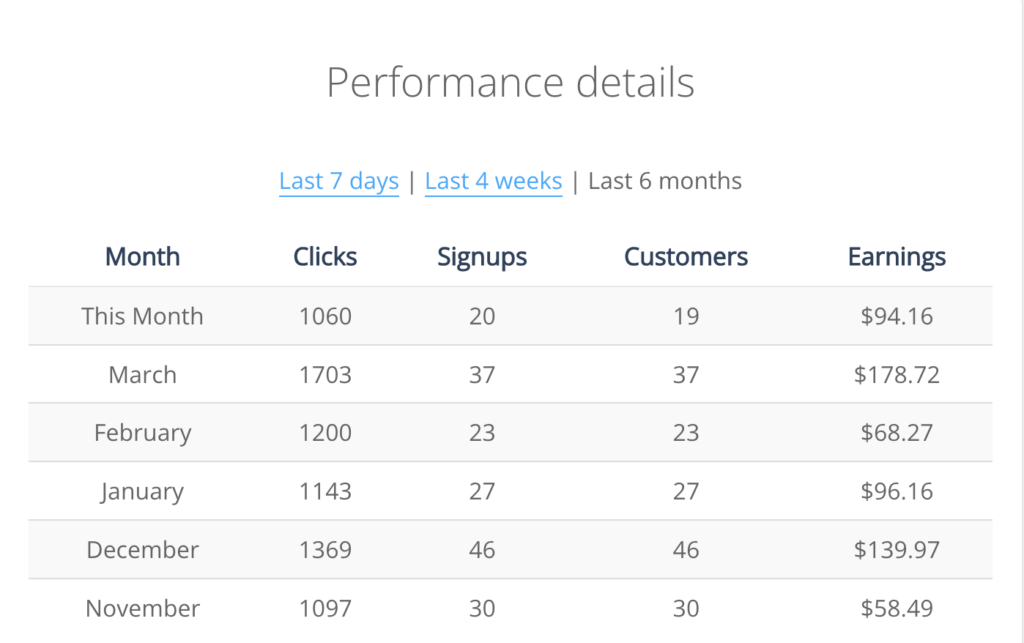
It gets about 5,000 monthly reads and about 1,000-2,000 clicks to affiliate products. About 1-3% of those clicks convert to customers. This means this single blog post makes about $100/month.
This post took about 5 hours to write.
Of course, not all posts do this good. But then some do much, much better than that. 🙂 I sometimes earn more than $10,000/month from my affiliate posts combined.
There are so many things that contribute to what you can earn as an affiliate marketer. Here are some of the most notable factors to consider:
Niche: The niche you choose can play a significant role in how much you can earn from affiliate marketing. Certain niches like finance and technology have higher commissions compared to other niches. For example, in the software niche, there might be 30-50% affiliate commissions—that are recurring.
Traffic: The amount and quality of traffic your website receives can impact your earnings. A higher volume of targeted traffic from high-earning countries (like the US) can lead to more clicks and conversions.
Commission rates: The commission rates offered by the affiliate programs you join can vary significantly. Higher commission rates can lead to higher earnings. Some niches do 1-3% commission—others as high as 50%!

Conversion rates: The percentage of website visitors who end up making a purchase or completing a desired action (such as filling out a form or subscribing to a newsletter) can impact earnings. Usually, a good affiliate post might get a 1-2% conversion rate.
Affiliate program selection: The affiliate programs you choose to join can have different commission rates, payment structures, and support resources, which can all impact your earnings.
Content Strategy: The quality of your website’s content, optimization for search engines, and overall content strategy can impact the volume and quality of traffic you receive, as well as your conversion rates.
Competition: The level of competition in your niche can impact your earnings, as well as your ability to rank well in search engines and attract traffic. If you can’t rank in the top 10, you won’t earn much! Targeting too competitive search phrases can stall your progress.
Marketing and Promotion: The marketing and promotion strategies you use can impact the amount and quality of traffic you receive, which can, in turn, impact your earnings.
Product or Service Quality: The quality and value of the products or services you promote can impact your conversion rates and ultimately, your earnings.
Website Design and User Experience: A well-designed website with a good user experience can help build trust with your audience, which can lead to more conversions and higher earnings.
Wrapping Up
To start a successful affiliate business, you need to choose a space you want to make better.
In other words, you need to pick a niche and write a ton of useful informational content about that niche.
After writing a ton of valuable and unique content, Google and other search engines trust your site.
At this point, you can start publishing affiliate posts that recommend products in the niche.
So basically, you build an expert site around a particular topic and help people in that space! That’s what affiliate marketing is these days.
Before, you could just start a random domain and write a ton of irrelevant affiliate content and still rank high. But gone are those days—and that’s good.
There’s no room for “SEO hackers” to modify the search results anymore.
Remember to always provide value. Write the best blog posts on the internet.
Otherwise, the chances for success are slim to none. Don’t believe in growth hacks. Becoming a successful affiliate marketer takes a ton of time. It’s a business like any other!
